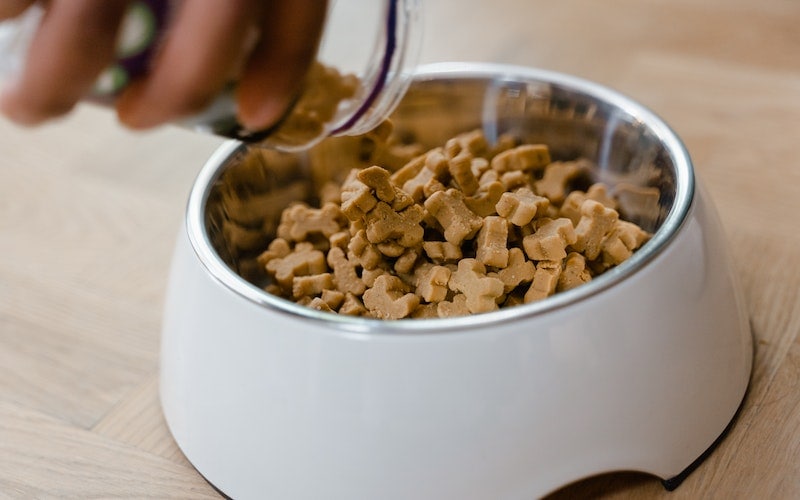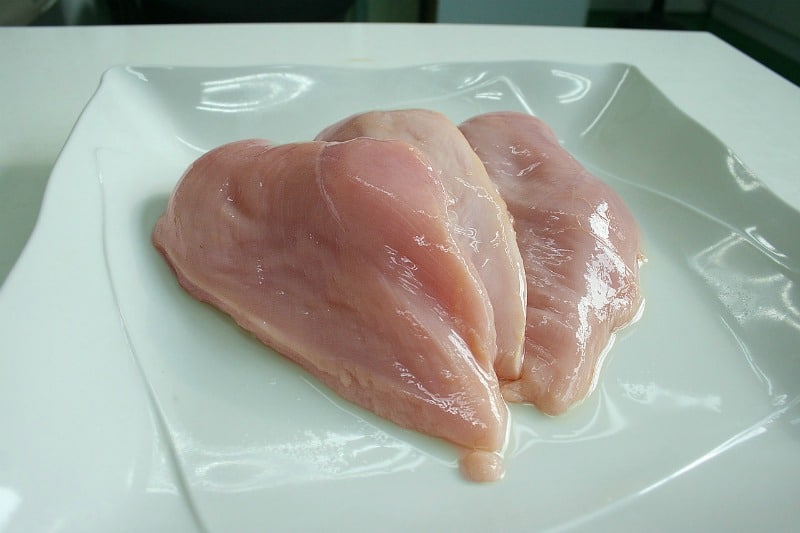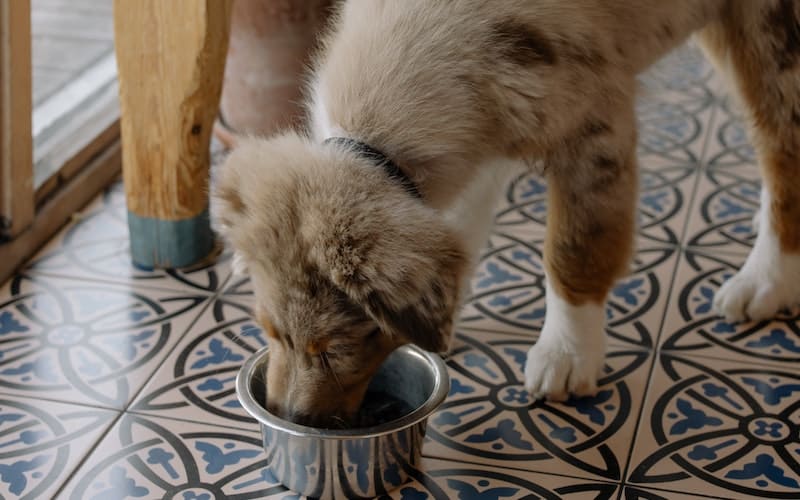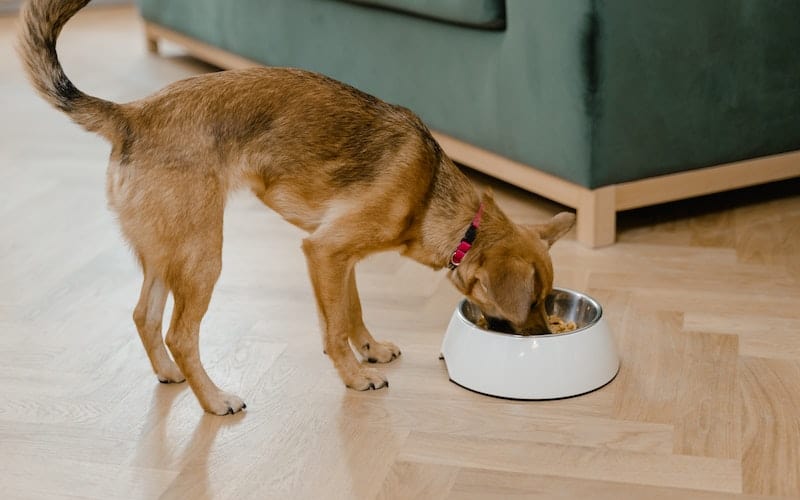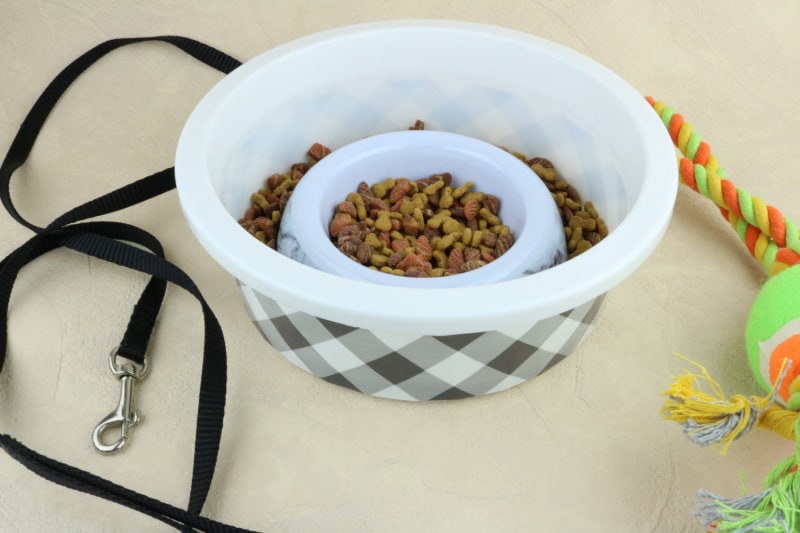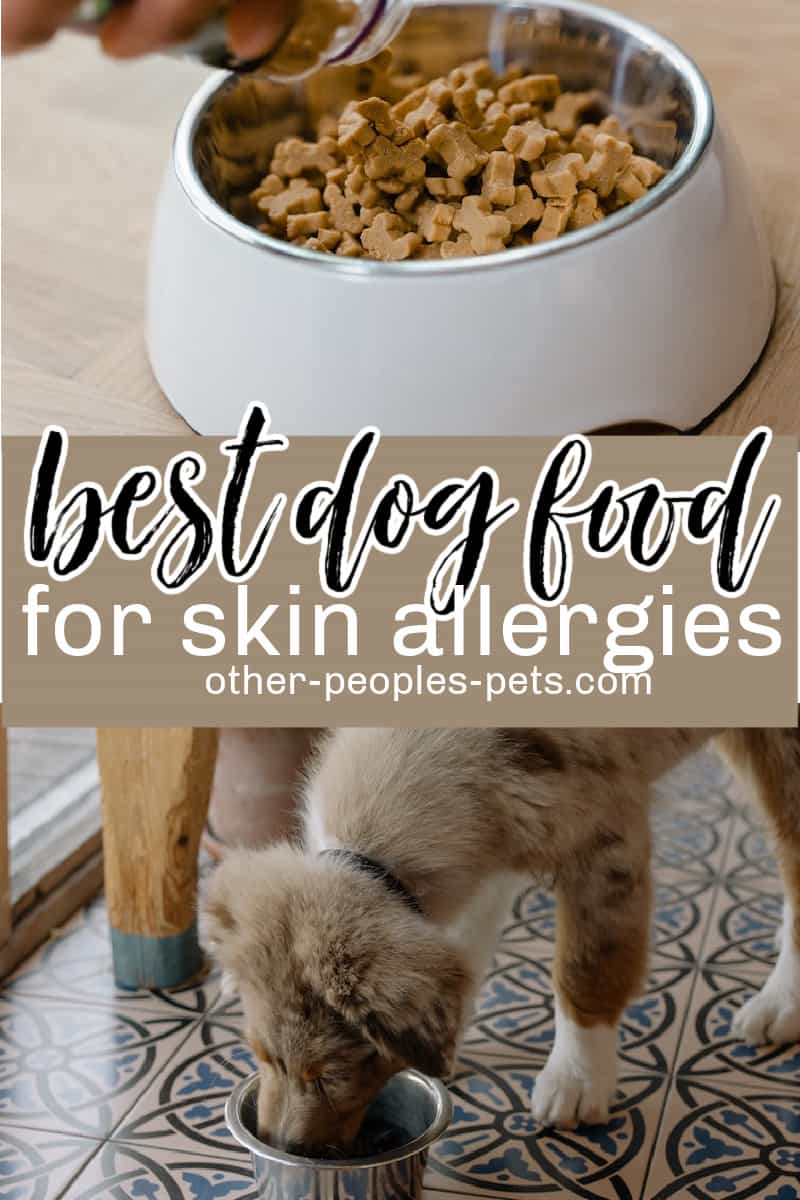Last Updated on September 19, 2023 by ellen
What is the best dog food for dog with skin allergies? Keep reading to learn more about dog food for allergies and how to support your pet’s immune system.
Posts may be sponsored. This post contains affiliate links, which means I will make a commission at no extra cost to you should you click through and make a purchase. As an Amazon Associate I earn from qualifying purchases.
Table of Contents
Best Dog Food for Dog with Skin Allergies
The dog food aisle at the grocery store can be overwhelming. There are dozens of choices for dry dog food and wet food for an adult dog.
If your dog has food allergies, you might be wondering if you need a prescription diet or if there are foods at the grocery store that are good for a dog with a food allergy.
When your furry friend has skin allergies, finding the right food is very important. Some dogs may react to common ingredients like beef, chicken, or wheat.
You need to find a food that doesn’t have these triggers. It might be a good idea to try “limited ingredient” or “hypoallergenic” dog foods. These kinds of foods often have fewer things that can cause a reaction.
But remember, every dog is unique. What works for one may not work for another. Always talk to your vet before changing your dog’s diet.
Common food allergies in dogs
Beef: It is a common ingredient in dog food. Some dogs may develop an allergic reaction to it.
Dairy: Some dogs are lactose intolerant. They may exhibit reactions to dairy products.
Wheat: Gluten intolerance can also be found in dogs, leading to wheat allergies.
Chicken: Despite being a popular protein source in dog food, some dogs are allergic to chicken.
Soy: This plant-based protein can also trigger allergies in some dogs.
Can dog food cause skin allergies in dogs?
Yes, dog food can indeed cause skin allergies in dogs. Similar to humans, dogs can have reactions to certain foods. This can trigger an immune response that manifests as skin allergies. Allergic reactions in dogs are often due to proteins present in their diet, typically from animal or plant-based sources.
When a dog is allergic to a certain food component, it means its immune system mistakes this harmless substance for a threat and responds defensively. The immune response can lead to inflammation, which often manifests as itching, redness or other skin problems.
This allergic reaction is not immediate and can take from hours to days to show symptoms, which often involve intense scratching or visible skin issues such as redness, rashes, or hot spots.
To determine if food is the cause of your dog’s skin allergies, a vet might recommend an elimination diet, where potential allergens are removed from the diet one by one to see if symptoms improve. It is crucial to seek professional advice in these situations as each dog is unique and what may alleviate symptoms in one dog might not necessarily work for another.
What foods should dogs with skin allergies avoid?
Dogs with skin allergies should ideally avoid foods that are known to commonly cause reactions. As mentioned, these can include beef, dairy, wheat, chicken, and soy. It’s important to remember that just because these are common allergens, it doesn’t mean your dog will necessarily be allergic to them. Each dog is unique and may react differently to different foods.
For dogs with known food allergies, it’s best to feed them a diet that does not contain the allergen. This might mean switching to a dog food that uses a different protein source, such as fish or lamb, or one that uses different grains, or is grain-free. Additionally, hypoallergenic dog foods or those with limited ingredients can also be a good choice, as these are specifically designed to minimize the likelihood of causing allergic responses.
In addition to avoiding known allergens, it can also be beneficial to include certain foods in your dog’s diet that may help boost their immune system and improve skin health. These might include foods rich in Omega-3 fatty acids, such as fish and flaxseeds, or those high in vitamins and antioxidants, like fresh fruits and vegetables.
However, always consult with your vet before making any major changes to your dog’s diet.
Is wet food better for dogs with skin allergies?
The type of food you choose for your dog depends on their individual needs and preferences. Wet food isn’t necessarily better for dogs with skin allergies. However, some dogs might benefit from wet food as it tends to be more palatable and may help increase a dog’s overall water intake. Hydration is important for maintaining healthy skin.
When it comes to allergies, the ingredients in the food, not the form of the food, are the most important factor. Both wet and dry dog food can be hypoallergenic, or designed for dogs with allergies, depending on the ingredients used. Look for dog food that does not contain the allergens that affect your dog.
While wet food isn’t inherently better for dogs with skin allergies, it might be a good option if your dog has other health issues, like kidney disease or dental problems.
Regardless of whether you choose wet or dry food, always consult with your vet before making changes to your dog’s diet.
Ask them for their recommendation for dog food for allergies. I’ve included our top picks for the best dog food for food allergies. They avoid common food allergens.
What is a limited ingredient diet?
A limited ingredient diet for dogs is a type of diet that is designed to minimize the potential for allergic responses by reducing the number of ingredients your dog is exposed to. It is especially beneficial for dogs with known food allergies or sensitivities.
In a limited ingredient diet, there is usually a single source of animal protein and a minimal number of carbohydrate sources. This approach helps to simplify the diet and makes it easier to identify and control the ingredients that might cause an allergic response in your dog.
However, it’s important to remember that a limited-ingredient diet should still provide complete and balanced nutrition for your pet. It needs to contain all the necessary nutrients a dog needs for its health and well-being. Always consult with your vet or a pet nutritionist to ensure that any diet, including a limited ingredient diet, meets your dog’s dietary needs.
What are signs of an allergic reaction in dogs?
Allergic reactions in dogs can manifest in various ways, and skin allergies are among the most common signs. These allergic responses usually appear as skin-related issues, and you may notice changes in your dog’s behavior and appearance.
One of the most noticeable signs of an allergic reaction in dogs is excessive itching or scratching. Your dog may continuously nibble or chew on certain areas, causing hair loss or skin abrasions. Another common sign can be redness of the skin. This could be in patches or across larger areas of the dog’s body and may appear irritated or inflamed.
Other signs can include rashes, hives, or sores on the skin. These may be accompanied by swelling in certain areas, particularly the face, ears, and paws. In severe cases, dogs may also experience vomiting or diarrhea if the reaction stems from a dietary source. It’s crucial to monitor your dog’s behavior and physical changes closely and consult with a vet if you suspect they’re experiencing an allergic reaction. It’s always better to err on the side of caution when it comes to your pet’s health.
What are hypoallergenic dog foods?
Hypoallergenic dog foods are types of food specially designed to minimize the chance of causing an allergic reaction in dogs. These foods are made with ingredients that are less likely to trigger allergies.
For example, they often use proteins that have been broken down into smaller pieces, known as hydrolyzed proteins. These smaller pieces can be easier for your dog’s body to digest and are less likely to cause a reaction.
In addition to hydrolyzed proteins, hypoallergenic dog foods might also use novel proteins and carbohydrates which can be better for a dog with a food allergy. These are types of protein and carbohydrate that your dog has not been exposed to before, and so is less likely to be allergic to.
Examples can include proteins like venison, rabbit, or kangaroo, and carbohydrates like peas or sweet potatoes. However, it’s essential to consult with your vet before switching your dog to a hypoallergenic diet.
Other causes of skin allergies in dogs
Other potential causes of skin allergies in dogs can include environmental factors, parasites, and certain materials.
Environmental factors: This includes things like pollen, dust mites, or mold. Just like humans, dogs can be allergic to certain elements in their environment and these can cause allergic reactions resulting in skin issues.
Parasites: Fleas and ticks are not uncommon in dogs, and some dogs can have an allergic reaction to their bites, causing severe itching and skin irritation.
Materials: Dogs can also develop allergies to certain types of materials, such as specific fabrics in their bedding or types of plastic in their toys or feeding bowls. This can result in contact dermatitis, which is characterized by redness, itching, and inflammation of the skin.
This product presentation was made with AAWP plugin.
Royal Canin Veterinary Diet HP Dog Food
Royal Canin Veterinary Diet HP Dog Food is a premium product specifically tailored to address the nutritional needs of dogs requiring hypoallergenic diets. Made with carefully chosen high-quality ingredients, it uses hydrolyzed proteins to minimize the risk of allergic reactions. Find it here.
This product presentation was made with AAWP plugin.
Canindae Grain Free Pure Dog Food
Canidae Grain Free Pure Dog Food is an exceptional choice for pet parents seeking a simple, wholesome solution for their furry friends. Crafted with a limited number of carefully selected ingredients, this grain-free formula is designed to help dogs with sensitive stomachs or food-related allergies.
It features a high-quality protein source as its first ingredient, complemented by a range of nutritious fruits and vegetables. This dog food is free of additives and artificial ingredients, ensuring your dog receives only the very best nutrition. Get it here.
This product presentation was made with AAWP plugin.
Blue Buffalo Natural Veterinary Diet NP Dog Food
Blue Buffalo Natural Veterinary Diet NP Dog Food caters to the needs of dogs with food sensitivities or allergies. It features novel proteins and carbohydrates, which are less likely to trigger food allergy reactions, making it a suitable choice for dogs that require a hypoallergenic diet.
The key ingredients in this dry dog food are selected for their nutritional value and digestibility, ensuring that your pet gets a balanced, healthy diet. Just like all Blue Buffalo products, it does not contain any artificial additives, offering a natural, wholesome food option for your pet. Buy it now.
This product presentation was made with AAWP plugin.
Wellness Simple Limited Ingredient Lamb & Oatmeal Dog Food
Wellness Simple Limited Ingredient Lamb & Oatmeal Dog Food is a specially formulated recipe designed for dogs with food sensitivities or allergies. As the name suggests, it has a simple yet balanced mixture of ingredients, primarily lamb and oatmeal. Lamb serves as a high-quality, easily digestible protein source. Oatmeal is a non-allergenic carbohydrate. It provides your dog with sustained energy.
This dry dog food food avoids the common allergens. It is a safe choice for dogs prone to dietary reactions. As with all Wellness products, it’s free of artificial additives. This ensures your pet enjoys a wholesome, natural diet. It’s a great choice for dogs with food allergies. Buy it now.
This product presentation was made with AAWP plugin.
Hill’s Prescription Diet Food Sensitivities Dog Food
Hill’s Prescription Diet Food Sensitivities Dog Food is a specially designed dietary solution for dogs dealing with food sensitivities or allergies. Formulated under the guidance of veterinarians and nutrition scientists, it includes novel proteins and carbohydrates to reduce the risk of allergic reactions.
They selected the key ingredients to provide maximum nutritional benefit without compromising on taste. As part of Hill’s Prescription Diet range, this food is made with the highest quality ingredients and offers a reliable, vet-approved choice for managing your pet’s food sensitivities. Get it here.
How to switch my dog to a new food
Switching your dog to a new type of food should be a gradual process. This will avoid upsetting your pet’s stomach. Start by mixing a small portion of the new food with the old one. In this initial stage, the old food should constitute about 75% of the total mix. The new food should be approximately 25%. Maintain this ratio for several days. Observe your pet for any signs of discomfort, such as vomiting, diarrhea, or loss of appetite.
If your dog seems to be accepting the new food without any adverse reactions, you can start to increase the portion of the new food gradually. Over the next week or two, slowly alter the ratio until it’s about 50% old food and 50% new food. Continue to monitor your dog’s behavior and health during this transition period. If any digestive issues arise, it would be wise to slow down the transition process, or consult with your vet.
Finally, once your dog seems comfortable with a 50/50 split, you can continue to increase the proportion of the new dog food. After a week or so, try a mix of 75% new dog food and 25% old food. If your dog still shows no signs of discomfort, you can eventually move to 100% new food. Remember, changing a dog’s diet isn’t a race. The slower you go, the better it is for your dog’s digestive health and overall comfort when it comes to food allergies.
Other ways to promote healthy skin for your dog
So, in addition to a balanced diet, consider incorporating fish oil into your dog’s daily regimen if they have a food allergy. Fish oil is rich in Omega-3 fatty acids. This improves the health of your dog’s skin and coat. These healthy fats help to moisturize the skin from within. They reduce flakiness and promote a shiny, healthy coat. Similarly, chia seeds and flaxseeds are excellent sources of these beneficial fats.
Always consult your vet before starting any new supplement or dog foods. This will ensure it’s safe and beneficial for your pet. In conclusion, a diet rich in healthy fats is one of the keys to maintaining your dog’s coat health and overall well-being.
Related Reading
Finally, you may also enjoy these articles.

Ellen runs a small pet sitting business in southern Vermont. She has experience with a variety of small animals, dogs and cats. She has also cared for ducks, chickens and rabbits. Combined, she has over 20 years of experience in pet care and pet sitting.
